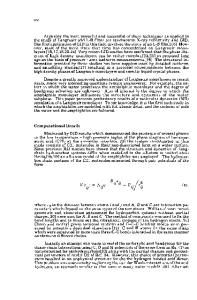Molecular dynamics simulation of point defect accumulation in 3C-SiC
- PDF / 69,618 Bytes
- 6 Pages / 612 x 792 pts (letter) Page_size
- 4 Downloads / 347 Views
R4.1.1
Molecular dynamics simulation of point defect accumulation in 3C-SiC R. Devanathan, F. Gao, and W. J. Weber. Fundamental Science Directorate, Pacific Northwest National Laboratory Richland, WA 99352, U.S.A. ABSTRACT Defect accumulation in silicon carbide has been simulated by molecular dynamics using a Brenner-type potential connected smoothly to the Ziegler-Biersack-Littmark potential. Displacement damage in 3C-SiC, which is known to consist of point defects, vacancy and interstitial clusters and anti-site defects, was modelled by introducing random displacements on the Si or C sublattice. SiC was amorphized by Si displacements at a damage level corresponding to 0.15 displacements per atom (dpa) and by C displacements at 0.25 dpa. In both cases, the damage consists of Si and C Frenkel pairs as well as anti-site defects. The results provide evidence that SiC can be amorphized by displacing C atoms exclusively and suggest that shortrange disorder provides the driving force for amorphization of SiC.
INTRODUCTION SiC is a wide-band gap semiconductor with potential electronic applications in areas where silicon is unsuitable. A combination of excellent properties such as low leakage current, high intrinsic temperature, good thermal conductivity, high electric field breakdown strength and chemical inertness make it a promising candidate for high temperature electronics, high-power high-frequency semiconductor devices, and radiation-hard electronics [1]. SiC can be thermally oxidized to form device quality SiO2, which enables the manufacture of SiC metal oxide semiconductor field effect transistors (MOSFET). During device processing, the extremely low diffusion coefficient of dopants necessitates ion implantation of dopants into SiC. High dose ion implantation can lead to atomic level defect production and eventual amorphization of SiC resulting in degradation of physical properties [2]. To advance SiC device technology, there is a pressing need to understand atomic level damage production in SiC by ion-implantation. Numerous experimental studies have examined damage accumulation in SiC by energetic particle irradiation [3-10]. These studies have shown that SiC is amorphized by electron irradiation below about 350 K [3] and ion irradiation below about 550 K [4]. The critical dose for amorphization at about 30 K, where there is minimal thermal recovery of damage, was found to be about 0.2 dpa for ion [4] and 0.5 dpa for electron [3] irradiation. The volume swelling upon amorphization by ion irradiation was found to be about 14-17% [5-7]. Bulk amorphization of SiC by neutron irradiation to 2.6 dpa at 350 K has been reported to occur with a swelling of 11% [8]. Recently, SiC has been amorphized by 200 keV electrons at 300 K [9]. The energy transferred by 200 keV electrons is well above the displacement threshold for C, while it is at the displacement threshold for Si. However, Si atoms in SiC may be displaced with 200 keV electrons via the electron-C-Si collision sequence discussed by Zinkle and Kinoshita [10], espe
Data Loading...










